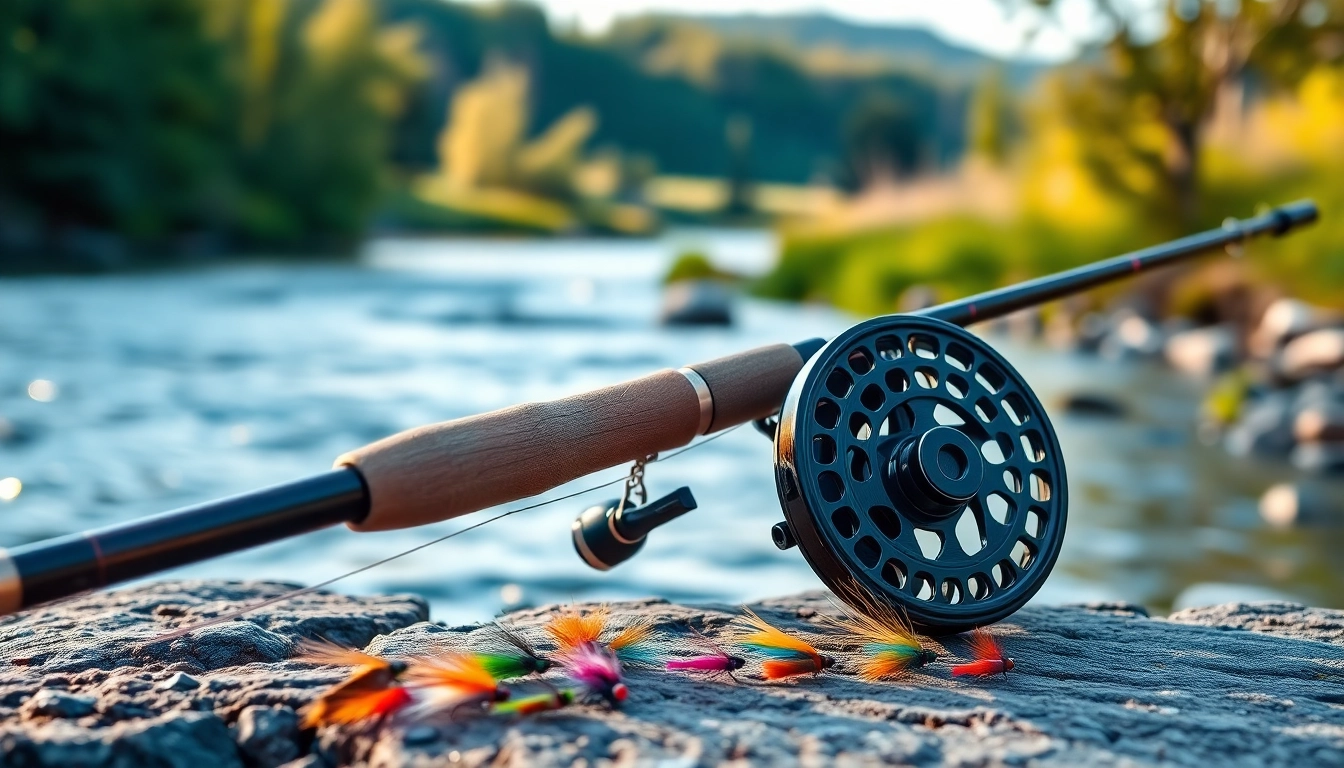Understanding Fly Fishing Combo Basics
What is a Fly Fishing Combo?
A Fly fishing combo refers to a package that typically includes the essential gear needed for an effective fly fishing experience. This kit generally comprises a fly rod, a fly reel, and included fly line, making it easy for beginners and enthusiasts to start fishing without the need to purchase each component separately. The convenience of having a pre-matched setup enhances the fishing experience by ensuring that all components are compatible, streamlining the selection process for anglers at all skill levels.
Components of a Fly Fishing Combo
A standard Fly fishing combo includes several key components:
- Fly Rod: The foundation of any fishing setup, the fly rod is long and flexible, designed to propel lightweight flies into various types of water. Rods generally range from 7 to 10 feet in length, with different weights categorized to target specific species.
- Fly Reel: The reel is utilized for storing and managing the fly line. Although its primary function is to hold the line, it also plays a crucial role in controlling the fish during the catch process. Fly reels come in various styles and sizes, corresponding to the rod’s weight.
- Fly Line: This specially coated line is thicker and heavier than regular fishing line to allow for the casting of lightweight flies. The weight and taper of the line affect casting distance and precision.
- Backing Line: This is a strong, thin line that attaches the fly line to the reel, offering extra line in case a fish runs far.
- Leaders and Tippets: These are essential parts of the setup, serving as the segment of line that connects the fly to the heavier line and allows for a finer presentation of the fly.
Benefits of Using a Fly Fishing Combo
Investing in a Fly fishing combo brings numerous advantages:
- Convenience: First-time users appreciate the simplicity of starting their fishing journey with an all-in-one package that saves them from the hassle of selecting individual components.
- Cost-Effectiveness: Purchasing a combo typically proves cheaper than buying each piece separately, allowing anglers to save money while gaining quality gear.
- Compatibility: All parts are designed to work harmoniously, eliminating doubts over mismatched equipment that can lead to frustration.
- Quality Assurance: Reputable manufacturers ensure that their combos comprise reliable components that endure the test of time.
- Flexibility Across Skill Levels: Combos are available for various proficiency levels, ranging from beginner kits that emphasize ease of use to advanced combinations featuring specialized components.
Choosing the Right Fly Fishing Combo for Beginners
Factors to Consider When Selecting Your First Fly Fishing Combo
For those new to the sport, choosing the right Fly fishing combo involves several important considerations:
- Rod Length and Weight: A 9-foot medium-weight rod (5 or 6 weight) is an excellent choice for beginners, offering versatility for various fishing conditions.
- Ease of Use: Look for a combo that includes a reel with a smooth drag system and simple mechanics, allowing for worry-free operation.
- Material: Graphite rods are lightweight, making them easy to manage, while fiberglass options are more durable, though heavier.
- Storage and Portability: Compact gear can be more convenient for travel, especially for those who enjoy fishing in various locations.
- Affordability: As a newcomer, prioritizing budget options can be wise. Good quality doesn’t always equate to high prices.
Best Parsimony Practices for Beginners
For beginners, it’s crucial to practice frugality while ensuring quality. Here are tips to achieve this:
- Research thoroughly: Compare different models and reviews online to gauge the best value. Read user opinions on various platforms.
- Leverage Community Feedback: Engage with local fishing groups or forums to uncover recommendations for affordable yet reliable options.
- Start Simple: Rather than going for overwhelming setups with many extras, opt for beginner combos that focus on the basics.
- Test the Waters: Try a few different setups via rentals or borrow from experienced anglers before committing to a purchase.
Resources and Tools for Learning
Taking advantage of available resources is critical for any beginner. Here’s how to access helpful tools:
- YouTube Tutorials: Many anglers share insights and tutorials on fly fishing techniques. Visual demonstrations can clarify complex concepts.
- Online Courses and Workshops: Platforms cater to different levels. Search for local classes or online courses to build fundamental skills.
- Networking with Experienced Anglers: Join local clubs, attend events, and participate in outings to learn first-hand from more experienced fishers.
- Books and Articles: Numerous publications delve into the mechanics of fly fishing, from casting techniques to gear maintenance.
Intermediate Fly Fishing Combo Options
Upgrading Your Fly Fishing Combo
As anglers grow more experienced, enhancing their Fly fishing combo becomes a common endeavor. Upgrading involves assessing components and investing in specific areas:
- Rod Upgrades: Consider rods with faster actions that provide enhanced casting control and fish-fighting capabilities.
- Advanced Reels: Look for reels equipped with high-quality drag systems that permit precise adjustments during the catch.
- Line Innovations: Opting for specialty lines tailored for particular water conditions or fish species can elevate the fishing experience.
- Customization: Adding personal touches can increase comfort and performance; for instance, selecting a reel handle or grips that fit your fishing style.
Additional Gear to Enhance Your Experience
Intermediate anglers can also benefit from investing in ancillary gear that complements their Fly fishing combo:
- Waders and Boots: Protecting oneself from cold water and ensuring stability on slippery banks enhances comfort and safety.
- Fishing Vest or Pack: A designated gear carrier ensures all essential tools and tackle are organized and easily accessible.
- Fly Boxes: Keeping flies organized allows for quick access and keeps gear streamlined for easy transitions.
- Tools and Accessories: Tools such as nippers and forceps improve efficiency in handling flies and fish, while accessories like fishing nets aid in safe landings.
Techniques for Effective Use
To maximize effectiveness with an upgraded Fly fishing combo, consider adopting these advanced techniques:
- Presentation Techniques: Master casting distance, timing, and angles to present flies more naturally.
- Understanding Hydrology: Knowing how water flow and current affect fish behavior leads to successful targeting.
- Employing Varied Retrieval Techniques: Adjust retrieves based on fish response, experimenting with speeds and patterns to identify which draws the most bites.
- Fine-Tuning Your Rig Setup: Understand distinct rigs and knots for different settings to optimize your approach.
Advanced Fly Fishing Combo Techniques
Customizing Your Fly Fishing Combo
Experienced anglers often seek to customize their Fly fishing combo to enhance personal effectiveness:
- Custom Rods: Consider crafting or purchasing bespoke rods tailored to your desired specifications for weight and action.
- Reel Upgrades: Replacing generic reels with those supporting specialized drag systems can improve your ability to manage larger fish.
- Line Selection: Tailor your line to specific fishing conditions by experimenting with floating, sinking, or sink-tip lines.
- Accessory Modifications: Personalizing your vest or pack with custom compartments and attachments can lead to a more streamlined experience.
Analyzing Gear Performance
Close attention to gear performance helps ensure optimal results. Here are ways to analyze your Fly fishing combo:
- On-Water Testing: The best method for assessing equipment is to use it in varying conditions, observing how it performs in live scenarios.
- Feedback Logs: Keeping records of successful outings, conditions, and gear performance can lead to insights into how your combo performs over time.
- Peer Consultations: Discuss experiences and gather insights from fellow anglers to identify potential gear issues and enhancements.
Specialized Combos for Specific Fishing Conditions
Different fishing contexts require tailored equipment. Here are examples of specialized Fly fishing combos:
- Saltwater Combos: Saltwater fishing often demands specialized rods and reels that resist corrosion and handle larger, stronger fish.
- Trout Combos: Lightweight configurations targeting trout typically focus on stealth, favoring smaller presentations that mimic prey accurately.
- Warm Water Combos: Nor are combos designed for warmer waters; they can handle both freshwater and saltwater environments.
Maintaining Your Fly Fishing Combo for Longevity
Cleaning and Care Tips
Regular maintenance is essential to extend the lifespan of your Fly fishing combo. Here are some cleaning and care tips:
- Rinse After Use: Always rinse your gear with fresh water after each use to remove contaminants like salt and dirt.
- Inspect Regularly: Regular visual inspections of rods and reels can help identify any damage or wear before it worsens.
- Use Proper Storage: Invest in protective gear cases and keep rods unbroken, stored vertically or horizontally to prevent bending.
- Lubrication: Periodically lubricate reel mechanisms according to the manufacturer’s guidelines to maintain smooth performance.
Storing Your Fly Fishing Combo Properly
How you store your Fly fishing combo is often just as important as how you maintain it:
- Avoid Direct Sunlight: Keeping gear away from excessive sunlight can help prevent degradation of materials over time.
- Use Rod Tubes: Transport your rods in protective tubes to reduce the risk of damage during travel.
- Store in a Dry Environment: Ensure that your fishing equipment is stored in a temperature-controlled environment away from humidity and moisture.
When to Replace Parts of Your Fly Fishing Combo
Understanding when to replace parts of your Fly fishing combo is critical for ongoing performance:
- Worn Fly Lines: Lifespan can vary, but generally replace fly lines showing significant wear, cracks, or consistent tangles.
- Reel Components: Replace gears or parts that exhibit significant rust, corrosion, or mechanical failure.
- Rod Sections: If you notice a decrease in performance or visible damage to the rod sections, it might be time to consider replacing the rod completely or consult a specialist for repairs.

